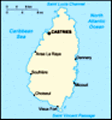Advertisement
Last night’s sunset was stunning. It’s not that the sky was suffused with an orange glow but rather that the tall, rain bearing clouds, were tinged grey and green. There was some rain overnight, but this morning, it was still hot and sticky. I lay in bed almost dreading having to go outside.
After a shower, I did go outside – for breakfast. I was not proved wrong; it was already hot and sticky.
Packing some water, I set off from the hotel for a round trip to Pigeon Island (
VIEW ROUTE).
The first part of the walk was rather tedious, being alongside the main road. Even the land crabs were not bothered about coming out into the heat. Cars passed by slowly as I trudged along the rough ground, passing Pirate Rentals and arriving at the Marina.
I suppose I really ought to say something about Rodney Bay. Sitting north of the capital, Castries, lies the sleepy village of Gros Islet. Whilst it’s now a fishing village, I suspect it was historically the residence of those working in the nearby sugar cane plantation. Gros Islet sits at the northern end of a bay, Rodney Bay. This swampy

 St. David moored in the Marina.
St. David moored in the Marina.
Not free the week I was looking to charter herarea was drained by the Americans during the 1940s as they established a US Naval Air Station. Designed to protect the Panama Canal, it only had a life of a few years. Today, Rodney Bay is a thriving town, full of bars, restaurants, hotels and shopping centres.
The Marina is a self-contained centre and is very well protected from the sea, providing very secure moorings during hurricanes. It is also the finishing point for a transatlantic race.
Today, in the soaring temperatures, the marina was a gentle haven from the bustle outside. St. David (a luxury yacht) was moored close by. This opulent Benetti build has well appointed decks and luxurious interiors, and boasts an oversized Jacuzzi, alfresco cinema and spacious sun deck areas for relaxation. Her accommodation sleeps 12 guests in six beautiful staterooms with room for a crew of 15. All of this for just US$200,000 a week. Sadly, she wasn’t available in the week I was looking for a charter.
Exiting the marina, I neared the boatyards and noticed a wooden brig moored up. This, I discovered, was used as the
Black Pearl in the deck scenes of Pirates of the Caribbean. It was
also used as the slave ship in Roots.
Continuing, I headed off the main road and down through Gros Islet. In comparison to the houses on the Cap Estate, these were nothing to write home about. However, people do live here and the houses are their homes. As such, they have been painted brightly and are generally well looked after. I think, in some way, they also have more character with their wooden walls having bravely stood against hurricanes.
Dropping onto the beach, the poorest live in shacks at the high water mark. A women wearing rags was holding her baby tight in the doorway of the family's ramshackle abode. Little children ran along the white sand, dashing into the blue sea as if to chase the waves away. A little old lady, wearing a bright blue traditional hat, sat in the shade of a very broken wooden box selling bananas and sweets. No one was queuing.
Here, the foreshore widened and it was possible for the locals to sit and have barbecues. At the top end of the beach was a contrast. The Landings and Sandals are two deluxe hotels sited on the causeway built in
the 1970s to Pigeon Island. Here, shiny, white people lay on sunbeds, their view of St. Lucia consisting solely of the drive up from the airport. A couple were getting married on the sand, the hotel staff hastily ushering me on out of the way. In St. Lucia, all beaches are public, so the more she hastened me, the slower I got, eventually stopping to talk to a local. I wonder whether I will appear in the wedding album as a local.
Finally, I arrived at Pigeon Island. Due to the Jazz Festival, it was not possible to enter the home of Jambe de Bois and Fort Rodney. However, I am attending the show tomorrow, so I will have a chance then.
By now, the temperature had peaked at 37°C and, as if in celebration, a tiny shower of rain attempted to put a dampener on things. On this side of the causeway, the sea was quite rough and white horses were blowing across the surface.
On land, there was little wind as I made my way back around the hotels and on to the beach at Gros Islet.
Cutting through the little village, I passed
folk sheltering from the heat. With little work, there was little for them to do. They sat there, chatting, in their jeans and t-shirts, both of which had not seen soap for a considerable period. However, a cheery
hello came from all, together with a big smile, gleaming white teeth puncturing their dark, weathered faces. Whilst they appeared to lack physical possessions, they still seemed to be positive. This is a trait I have seen in the mountains of Thailand, of Vietnam and of Laos, and a trait I have frequently seen here in St. Lucia – a humbling experience.
Advertisement
Tot: 0.15s; Tpl: 0.014s; cc: 21; qc: 89; dbt: 0.0796s; 1; m:domysql w:travelblog (10.17.0.13); sld: 1;
; mem: 1.3mb




















D MJ Binkley
Dave and Merry Jo Binkley
I love abandoned boat photos
This one is a beauty.